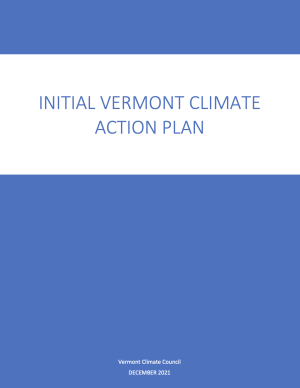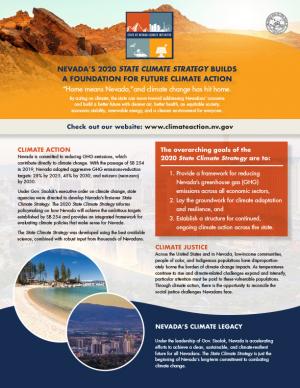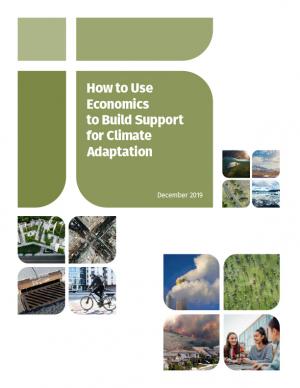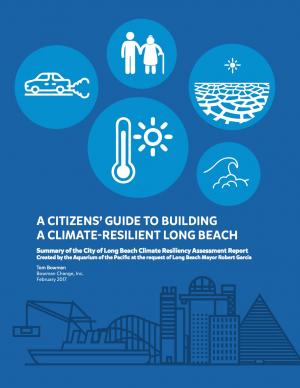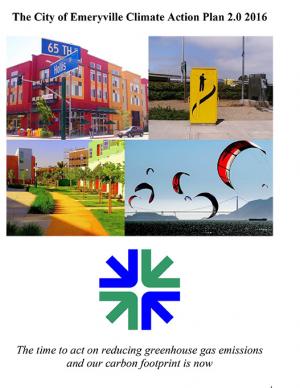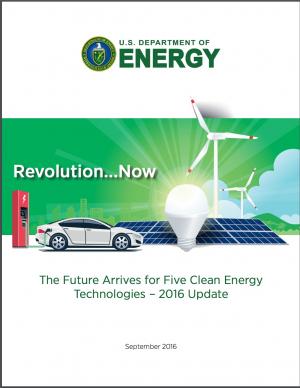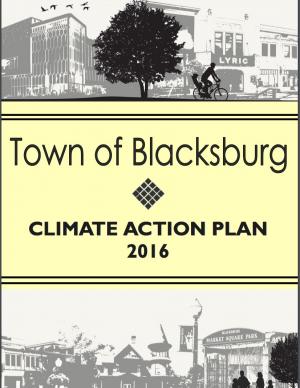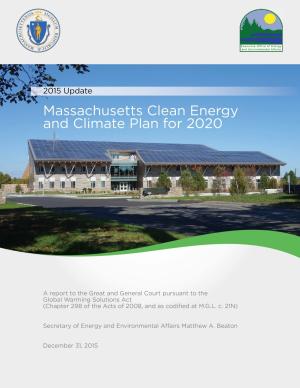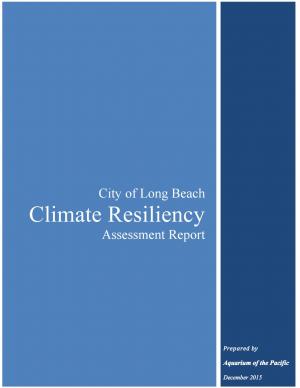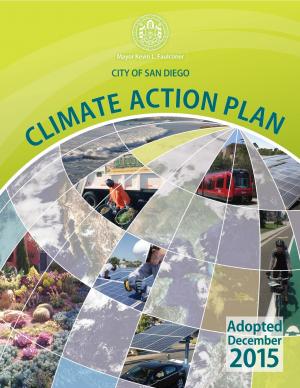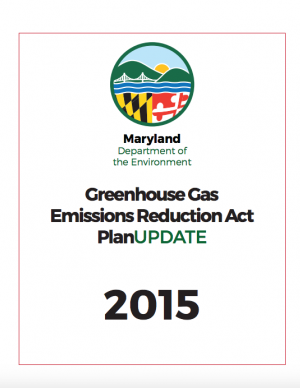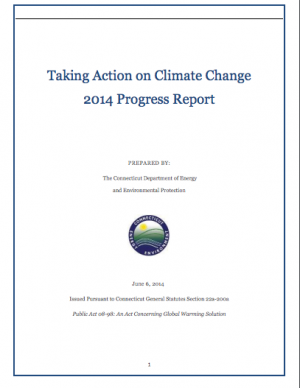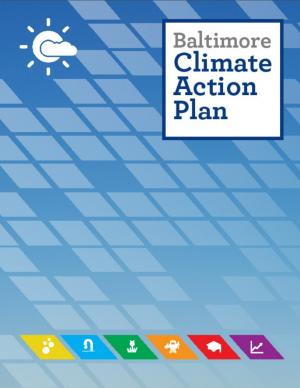Access a range of climate-related reports issued by government agencies and scientific organizations. Browse the reports listed below, or filter by scope, content, or focus in the boxes above. To expand your results, click the Clear Filters link.
The Vermont Climate Action Plan aims to dramatically reduce greenhouse gas emissions, help protect Vermont communities and landscapes from the greatest risks of climate change, and create new clean energy industry and jobs. The Climate Action Plan includes strategies to:
- Reduce greenhouse gas emissions from the transportation, building, regulated utility, industrial, commercial, and agricultural sectors;
- Encourage smart growth and related strategies;
- Achieve long-term sequestration and storage of carbon and promote best management practices to achieve climate mitigation, adaption, and resilience on natural working lands;
- Achieve net zero emissions by 2050 across all sectors;
- Reduce energy burdens for rural and marginalized communities;
- Limit the use of chemicals, substances, or products that contribute to climate change; and
- Build and encourage climate adaptation and resilience of Vermont communities and natural systems.
The Climate Action Plan serves as a guide for the Vermont Legislature in setting policy that supports climate change solutions for Vermonters and Vermont's landscape.
A range of resources documenting report preparation are available in the Climate Action Plan Appendices.
The 2020 State Climate Strategy informs policymaking on how Nevada will achieve the ambitious targets established by SB 254 and provides an integrated framework for evaluating climate policies that make sense for Nevada. This will optimize effectiveness of each given policy and therefore maximize the benefits for all Nevadans. By taking a smart, strategic approach to addressing climate change in Nevada, the state can fully capture the economic benefits of clean technologies and lead the way in the neighboring Western states.
This report presents recommendations for how state governments can develop climate-resilience financial systems that help local communities invest in protecting residents, businesses, public infrastructure, private property, and natural resources from climate-driven stresses and shocks. To help states consider and act on the recommendations, a State Climate Resilience Action Checklist (page 50) identifies the essential actions that states need to take to build a comprehensive approach to resilience, including a financial system. The report also offers an Inventory of Climate Resilience Actions.
A growing number of local governments are taking steps toward climate adaptation, mostly through the development of climate adaptation plans. However, the rate and pace of adaptation action has significantly lagged behind planning, especially in mid- and small-sized municipalities where resources are often limited and local politics may further delay action. This report describes how to use economics to build support for climate adaptation. Using case studies from cities large and small, it highlights how to effectively use economic data and methods, provides eight types of economic analyses for climate adaptation, and explains how to clearly communicate economic data to different audiences.
This guidebook results from the culmination of a year of dialogue among diverse stakeholders in southeastern Connecticut who defined challenges and solutions from extreme weather, climate change, and shifting social and economic conditions. Participants included representatives from nine municipalities, public and private utilities, public health departments, chambers of commerce, major employers, conservation organizations, academic institutions, community non-profits, and state agencies, among others. The dialogue captured six themed planning sectors (water, food, ecosystem services, transportation, energy, and regional economy) in a process that used surface and integrated solutions to address singular and multiple challenges across planning sectors. The guidebook provides a quick reference resource to help shape and inform actions that will advance a regional resilience framework for southeastern Connecticut; an accompanying Summary of Findings captures the project's final outcomes and conclusions, as well as providing a comprehensive account of the objectives, process, and details.
This user-friendly summary is based on the 2015 report “City of Long Beach Climate Resiliency Assessment Report" and “Appendices” prepared by the Aquarium of the Pacific at the request of Mayor Robert Garcia. The report includes clear infographics that describe current and projected conditions in the city. It also describe what the city is currently doing and what else the city and its residents can do.
Emeryville is the first city in California's Bay Area to update its Climate Action Plan and align its greenhouse gas (GHG) emissions targets with the State of California’s climate targets. This Climate Action Plan 2.0 includes updates to Emeryville’s 2008 Climate Action Plan, looking towards state targets for reducing 40 percent below baseline levels of GHG emissions by 2030 and 80 percent below baseline levels by 2050. The CAP 2.0 meets the compliance for the Global Covenant of Mayors, a platform for standardizing climate change action planning for local city governments and demonstrating local commitment to climate change mitigation and adaptation. The plan contains GHG targets, updated GHG community and municipal inventories, business-as-usual GHG forecast, deep decarbonization vision for 2050, adaptation and mitigation action plans, and a monitoring plan. With 17 mitigation goals, five adaptation goals, over 100 combined initiatives for 2030, and five long-term strategies for 2050, this CAP 2.0 represents a strong step in reducing emissions and building climate resilience.
This annual report details the progress made in reducing costs and ramping up deployments of clean energy technologies. In particular, the report highlights the progress of five clean energy technologies: wind turbines, solar technologies for both utility-scale and distributed photovoltaic (PV), electric vehicles, and light-emitting diodes (LEDs). The report also highlights emerging technologies that the Department of Energy believes have the potential to transform our energy sector over the next five to ten years. These include fuel-efficient technologies for heavy trucks, smart building controls, and vehicle lightweighting. Along with updates in these areas, the report also highlights the accomplishments and potential of fuel cells, industrial energy management, grid-scale batteries, and big area additive manufacturing.
Blacksburg's Climate Action Plan represents both a short- and long-term set of strategies to pursue to reach the community’s energy and climate action goals. The long-range goal, established by Town Council in 2007, is to reduce community-wide greenhouse gas emissions by 80 percent below 1990 levels by 2050. Blacksburg’s Climate Action Plan is divided into six chapters covering the major sectors of the community responsible for Blacksburg’s greenhouse gas emissions. Citizens' priority strategies are reflected in each of the sector chapters in three ways: a set of “Individual Actions” that citizens can choose to adopt in their own lives, shorter time-horizon “Let’s Get Started” strategies, and longer-term “Looking Ahead” strategies.
On Earth Day 2015, Connecticut Governor Malloy issued Executive Order 46 creating the Governor’s Council on Climate Change, also known as the GC3. The Council is to examine the effectiveness of existing policies and regulations designed to reduce greenhouse gas emissions and identify new strategies to meet the state’s greenhouse gas emissions reduction target of 80 percent below 2001 levels by 2050. It will do so, in part, by developing interim state-wide greenhouse gas reduction targets for years between 2020 and 2050 and by identifying short- and long-term statewide strategies to achieve the necessary reductions.
The Global Warming Solutions Act of 2008 required the Massachusetts Secretary of Energy and Environmental Affairs to set a limit on greenhouse gas emissions that would lead to a 10–20 percent reduction in emissions by 2020, and an 80 percent reduction by 2050. This update to Massachusetts' 2010 Climate Action Plan includes recommendations on how to achieve this goal.
In January 2015, Long Beach Mayor Robert Garcia asked the Aquarium of the Pacific to take a lead in assessing the primary threats that climate change poses to Long Beach, to identify the most vulnerable neighborhoods and segments of the population, and to identify and provide a preliminary assessment of options to reduce those vulnerabilities. Over the course of 2015, the Aquarium hosted and participated in meetings and workshops with academic and government scientists, business and government leaders, local stakeholders, and Long Beach residents to discuss key issues facing our community as the result of climate change. This report, completed in December 2015, represents the culmination of these efforts. The report offers detailed assessments of the five main threats of climate change to Long Beach: drought, extreme heat, sea level rise and coastal flooding, deteriorating air quality, and public health and social vulnerability. It also provides an overview of what is currently being done to mitigate and adapt to these threats, and other options to consider. Finally, this report presents a series of steps and actions that city leaders and community stakeholders can use as a template for making Long Beach a model of a climate resilient city.
With the goal of creating a cleaner San Diego for future generations, the City of San Diego’s Climate Action Plan calls for eliminating half of all greenhouse gas emissions in the City and aims for all electricity used in the city to be from renewable sources by 2035. The Climate Action Plan is a package of policies that will benefit San Diego’s environment and economy. It will help create new jobs in the renewable energy industry, improve public health and air quality, conserve water, more efficiently use existing resources, increase clean energy production, improve quality of life, and save taxpayer money. The plan identifies steps the City of San Diego can take to achieve the 2035 targets, including creating a renewable energy program, implementing a zero waste plan, and changing policy to have a majority of the City’s fleet be electric vehicles. The Climate Action Plan helps achieve the greenhouse gas reduction targets set forth by the State of California. The City’s first Climate Action Plan was approved in 2005 and a commitment to update the plan was included in the City’s 2008 General Plan update.
King County, Washington's Strategic Climate Action Plan sets forth strategies for reducing greenhouse gas emissions and preparing for climate change impacts.
This report updates the information contained within Maryland's 2012 Greenhouse Gas Reduction Act (GGRA) Plan. This document summarizes the state’s progress toward achieving the 2020 emissions reduction goal established by the GGRA and shows that Maryland is on target to not only meet, but to exceed, its emission reduction goal.
The purpose of this document is to promote state policy recommendations and actions that aim to help improve Colorado’s ability to adapt to future climate change impacts and increase Colorado’s state agencies' levels of preparedness, while simultaneously identifying opportunities to mitigate greenhouse gas emissions at the agency level.
In 1993, Portland was the first U.S. city to create a local action plan for cutting carbon. Portland’s Climate Action Plan is a strategy to put Portland and Multnomah County on a path to achieve a 40 percent reduction in carbon emissions by 2030 and an 80 percent reduction by 2050 (compared to 1990 levels). The 2015 Climate Action Plan builds on the accomplishments to date with ambitious new policies, fresh research on consumption choices, and engagement with community leaders serving low-income households and communities of color to advance equity through the City and County’s climate action efforts.
Successfully negotiating climate change challenges will require integrating a sound scientific basis for climate preparedness into local planning, resource management, infrastructure, and public health, as well as introducing new strategies to reduce greenhouse gas emissions or increase carbon sequestration into nearly every sector of California’s economy. This Research Plan presents a strategy for developing the requisite knowledge through a targeted body of policy-relevant, California-specific research over three to five years (from early 2014), and determines California’s most critical climate-related research gaps.
In September of 2013, Governor Jack Markell of Delaware signed Executive Order 41 directing state agencies to address the causes and consequences of climate change. The order asked for recommendations to reduce greenhouse gas emissions, increase resilience to climate impacts, and find ways to avoid or minimize flood risks caused by rising sea level. The order also created a committee to oversee the development and implementation of recommendations.
Virginia's Governor McAuliffe signed Executive Order 16 establishing the Virginia Energy Council in 2014; the council was formed to provide advice on the development and implementation of the 2014 Virginia Energy Plan. This plan was developed to provide a comprehensive view of where Virginia has been and currently is in terms of its energy assets, and it charts a path forward for energy policy in the commonwealth.
The report highlights the state’s achievement of returning to 1990 emissions levels by 2010. Additionally, Connecticut is likely to meet its goal of acheiving emissions levels 10 percent below 1990 levels before 2020. The report also presents the state’s climate adaptation and resiliency work.
On September 27, 2006, then-Governor Arnold Schwarzenegger signed California's Global Warming Solutions Act of 2006, which required the reduction of greenhouse gas emissions to 1990 levels by 2020. The California Air Resources Board is the lead agency for implementing the bill. One of the board's tasks was to create a scoping plan that would outline California’s strategy to achieve the 2020 greenhouse gas emission goal. This current scoping plan is an update from the original version, published in 2008. In addition to updates, this plan also contains progress reports on how California is progressing towards its goals.
This report, the first of its kind for the City of Grand Rapids, outlines the condition of the city's climate resiliency and offers recommendations for how it can both impact and adapt to climate change. The report's goal is to both spur a larger community conversation around processes that will enable Grand Rapids to become a more climate-resilient city and to spur many specific short- and near-term projects, policies, programs, and plans to mitigate the effects of climate change. The report documents projected local climate changes, their potential negative impact to low-income families, and outlines small near-term solutions that the city can make to curb or adapt to climate change. Recommendations include investing in green space and improving the city's tree canopy, improving the city's energy autonomy, and implementing green street infrastructure materials and maintenance techniques.
The Pennsylvania Climate Change Act requires the state's Department of Environmental Protection to submit an updated climate change action plan to the governor every three years. This report is the first update to the original plan issued in December 2009.
The Dane County Climate Change Action Council was formed in March 2013 with a mission to ensure that Dane County government was better prepared for weather extremes brought on by global climate change. The Council facilitated an internal review of county preparations and potential modifications to the operations and capital investments of the county, resulting in this report identifying Dane County’s potential vulnerabilities to weather extremes associated with global climate change and strategies to adapt to a changing climate. The report is the first step in the county’s effort to improve the resiliency of its climate-sensitive resources in the face of climate change; future steps will include cross-departmental collaborations to implement the adaptation strategies outlined in the report.
President Obama's Climate Action Plan includes a series of executive actions to reduce carbon pollution, prepare the United States for the impacts of climate change, and lead international efforts to address global climate change.
This Climate Action Plan represents Baltimore's commitment to being a leader in sustainability and improving their city environment. The plan contains feasible measures to help the city reduce greenhouse gas emissions and curb the effects of climate change. The plan calls for a goal of a 15 percent reduction in greenhouse gas emissions by 2020. In order to reach this goal, the plan promotes renewable energy generation and energy retrofits, waste diversion, and water efficiency. CAP measures will help citizens save energy and money, as well as encourage the use of sustainable modes of transit, high-density urban land use, and increased tree plantings. From the mayor's message: "While we as a City alone cannot change the course of world climate patterns, we must do our part. The City of Baltimore’s Climate Action plan is our promise to take action, reduce our greenhouse gas emissions, increase our quality of life, and grow Baltimore. "
Preparation of the Strategic Climate Action Plan is an opportunity to take stock of progress related to climate change, to look forward, and to plan for the future.
The report introduces key health connections to climate change mitigation strategies, suggestions of where these fit into a Climate Action Plan, a process for forging partnerships between planning and health organizations, links to data that will help planners identify and reference the existing health status of their jurisdiction, and supporting resources.
In November 2008, Governor Beshear of Kentucky issued a report that included a strategy to lessen carbon dioxide emissions and to reduce Kentucky’s carbon footprint. In 2010 the Kentucky Climate Action Plan Council (KCAPC) was established to assist in developing the Kentucky Climate Action Plan. The KCAPC was charged with producing a greenhouse gas emissions inventory and forecast, compiling a Climate Action Plan with recommended greenhouse gas reduction goals, and potential actions to assuage climate change and improve energy efficiency in various sectors. This document is the KCAPC's final report.
In August 2009, New York’s Governor, David Paterson, signed Executive Order 24 establishing a statewide goal of reducing greenhouse gas emissions 80 percent below 1990 levels by 2050. In addition, his Executive Order named the Climate Action Council to determine how to meet the goal. The Climate Action Council was also ordered to develop a plan to increase New York’s resiliency to a rapidly changing climate. This document is the council's interim report on New York's progress toward these goals.
In determining appropriate adaptation strategies, project staff worked with participants to survey a wide range of potential strategy options and develop a process for evaluation and prioritization of targeted strategies.
The Alaska Climate Change Sub-Cabinet was established on September 14, 2007, to advise the state's governor on creating a comprehensive Alaska Climate Change Strategy. This document contains the recommendations of the Adaptation Advisory Group, which was charged with evaluating and developing options to adapt to climate change. The report also includes background about projected climate impacts on Alaska.
This document sets forth a plan, required by Hawai'i's 2007 Session Laws, to achieve the maximum practically and technically feasible reductions in greenhouse gas emissions to or below 1990 levels of emissions by 2020.
The state of New Jersey enacted the Global Warming Response Act on July 2007, calling for a reduction in greenhouse gas emissions to 1990 levels by 2020 and further reduction of emissions to 80 percent below 2006 levels by 2050. This report was given to the Governor, Treasurer, and State Legislature in compliance with the Global Warming Response Act.
King County in Washington State has established a comprehensive program to prepare for climate change, and many of the tools and strategies that King County has employed can be applied in other communities. This memorandum from the King County Office of Strategic Planning and Performance Management, published by the American Planning Association, describes strategies developed in King County to direct local government efforts to address climate change.

